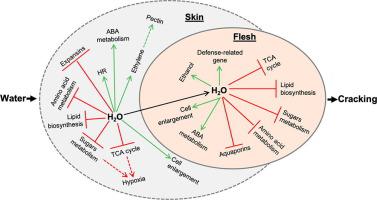Computational and Structural Biotechnology Journal ( IF 6 ) Pub Date : 2021-09-28 , DOI: 10.1016/j.csbj.2021.09.030 Michail Michailidis 1 , Evangelos Karagiannis 1 , Christos Bazakos 2, 3, 4 , Georgia Tanou 3, 5 , Ioannis Ganopoulos 2, 3 , Athanassios Molassiotis 1

|
Sweet cherry fruit cracking is a complex physiological disorder that causes significant economic losses. Despite many years of research there is a lack of understanding of the mechanisms involved in cracking. Here, skin and flesh tissue from the cracking susceptible 'Early Bigi’ and the cracking tolerant ‘Regina’ cultivars were sampled prior and just after water dipping treatment to identify water-affected metabolic networks that putatively involved in fruit cracking. Primary metabolites, most strongly those involved in sugars and amino acid metabolism, such as glucose and asparagine, shifted in 'Early Bigi’ compared with ‘Regina’ tissues following water exposure. Comparisons between cultivars, tissues and dipping points identified significant differentially expressed genes. Particularly, genes related to abscisic acid, ethylene biosynthesis, pectin metabolism, expansins and aquaporins were altered in water-exposed tissues. To further characterize the role of these genes in cracking, their single nucleotide variants of the coding regions was studied in another eight sweet cherry cultivars, which differ in their sensitivity to cracking, revealing a strong link mainly between pectin metabolism-related genes and cracking-phenotypes. Integrated metabolomic and transcriptomic profiling uncovered genotypic- and tissue-specific metabolic pathways, including tricarboxylic acid cycle, cell enlargement, lipid and ethanol biosynthesis, and plant defense that putatively are involved in fruit cracking. Based on these results, a model which describes the skin and flesh metabolic reprogramming during water-induced fruit cracking in the susceptible 'Early Bigi’ cultivar is presented. Τhis study can help to explore novel candidate genes and metabolic pathways for cracking tolerance in sweet cherry.
中文翻译:

基因型和组织特异性代谢网络和枢纽基因参与水诱导的不同甜樱桃果实开裂表型
甜樱桃裂果是一种复杂的生理疾病,会造成重大的经济损失。尽管进行了多年的研究,但仍缺乏对裂纹所涉及的机制的了解。在这里,在浸水处理之前和之后对来自易开裂的“Early Bigi”和耐开裂的“Regina”品种的皮肤和果肉组织进行采样,以确定可能与水果开裂有关的受水影响的代谢网络。主要代谢物,最强烈地涉及糖和氨基酸代谢的那些,如葡萄糖和天冬酰胺,与暴露于水后的“Regina”组织相比,在“Early Bigi”中发生了变化。栽培品种、组织和浸渍点之间的比较确定了显着差异表达的基因。特别是与脱落酸相关的基因,乙烯生物合成、果胶代谢、扩展蛋白和水通道蛋白在暴露于水的组织中发生了改变。为了进一步表征这些基因在裂化中的作用,在另外八个甜樱桃品种中研究了它们编码区的单核苷酸变体,这些品种对裂化的敏感性不同,揭示了主要与果胶代谢相关基因与裂化之间的密切联系。表型。综合代谢组学和转录组学分析揭示了基因型和组织特异性代谢途径,包括三羧酸循环、细胞增大、脂质和乙醇生物合成,以及推测与果实开裂有关的植物防御。基于这些结果,建立了一个模型,该模型描述了易受影响的水致果实开裂过程中的皮肤和果肉代谢重编程。介绍了早期的 Bigi 品种。这项研究有助于探索甜樱桃抗裂性的新候选基因和代谢途径。


























 京公网安备 11010802027423号
京公网安备 11010802027423号